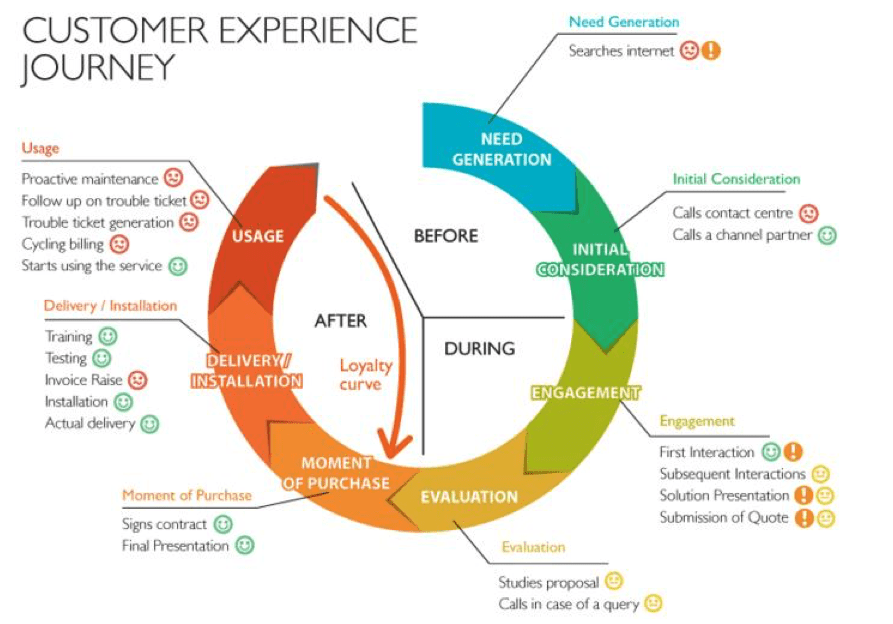Mapping the customer journey more accurately using surveys
In today’s highly competitive market, where product quality is not sufficient to get ahead, customer service becomes a key part of a company’s strategy. Consequently, the organization which successfully maintains the best relationship with its customers manages the best returns in terms of income.
As a result, companies have placed a new focus on understanding their customers in order to better their service, product or image. One of the main tools they use is the customer journey map.
A customer journey map, usually represented in a graphic and visual manner, is an interpretation of the entire experience that an individual has with a company, product or brand over time.
Mapping Out the Journey
Mapping out the interactions and experiences a customer has with a certain brand or product is only half the work that a customer journey map involves. After identifying all of the stages, from the customer’s initial interest in a general type of product or service to his using of the company’s product, surveys become essential.
A journey map is purposely designed to answer “the why and what”. It necessarily includes the main characters, a timeline, moments of interaction with the company from the perspective of the customer, the channels he or she used, but most of all it includes emotion.

Source
Man is an affective being, even when acting as an agent on the market. Frustration, happiness, satisfaction, curiosity or excitement dictate his economic behavior to a considerable extent. This is where the survey comes in.
At every stage of the process, skillfully asked questions can produce extremely useful answers. For example, a customer can reveal what it is about the product or brand that captivated his or her attention initially.
Moreover, the general availability of the product, the interactions with the staff, the motives for purchase, the usage period and all other subsequent interactions can be studied in more detail.
Due to its up close and personal interactions between staff and customers, the service industry felt the need to map out the customer journey most ardently. Panda Express, the largest Chinese food cuisine restaurant chain in the United States, routinely collects information through surveys.
The Panda Express survey not only seeks to reveal more about the specific interactions between the company and its customers, but also studies moments that create a lasting impression. These can be anything from enjoying a special offer or meal to a discussion with one of the supporting characters, usually friends or even staff, that contributed to the customer’s choice of the product. The paramount focus on emotions is understood throughout they survey.
Tools of the Trade
The interactions or touchpoints that an individual has with the company or its products is the focal point of a customer journey map. If the internet and various marketing tools today can pinpoint the exact moment when an individual becomes aware of a product, it cannot reveal his or her feelings toward it.
The survey comes as a completion of the quantitative data, adding information regarding the emotions caused by the product-customer interaction.
As in any customer satisfaction survey, questions should always be clear and on point. Moreover, in order to create the best survey to understand the customer journey, a logical progression of questions should be followed:
- A recount of the touchpoints identified by the customer. While these can be different and subtler in reality, the moment that the customer consciously established a relationship with the customer is important.
- A move from general to particular. The survey should move from feelings and emotions regarding the industry to specific ones relating to the company and its products or services. This string of questions can offer vital information regarding the company’s image and thus ways to improve it.
- A thorough elaboration of the customer’s experience at every stage of his interaction with the company. Even though individual experiences may radically differ, especially in terms of emotions, common points can be pinpointed and addressed within a wider marketing strategy.
- The identification of a decisive touchpoints or moments. Perhaps the most important type of questions that a survey should include are those meant to reveal the moment in which individuals become customers. Similarly, the moment in which he or she stops being a customer, for whatever reason, is of equal importance.
- Suggestions & Feedback. Questions regarding suggestions and feedback are essential for the betterment of the company’s products and services in the future.
Importance of Feedback
Some of the most successful corporations, active in competitive industries, heavily make use of customer surveys. Apple is perhaps the best example. Through its “Apple Customer Pulse” research group, the tech giant consistently issues online surveys and abides by the answers provided – enlarging its screens in order to better display videos and games, for example.
Similarly, McDonalds has made significant overhauls of its products, service and image after surveys have revealed concerns of customers regarding the food.
Customer journey maps are about establishing a connection and a level of compatibility between the company or its products and the target audience. In order to sell, companies must first identify a buyer.
Through surveys coupled with journey maps, the buyer is not only identified but fully explained, his needs and wants displayed over a larger period of time. By using that information, a company is able to not only expand its client base, but to retain customers and offer them an enhanced service. For that reason, creating the best possible survey is the first step toward improving customer services.

Jacey Larris is a Survey geek who evolved after years of documenting hundreds of technical processes and teaching others how to analyze results. After working in the IT field, becoming a Contributing Editor at
Survey Assistants became the next logical career path. Though hardware and software are some of her favorite projects, customer satisfaction has captured her interest for good. You can follow her on
Twitter.




 Jacey Larris is a Survey geek who evolved after years of documenting hundreds of technical processes and teaching others how to analyze results. After working in the IT field, becoming a Contributing Editor at
Jacey Larris is a Survey geek who evolved after years of documenting hundreds of technical processes and teaching others how to analyze results. After working in the IT field, becoming a Contributing Editor at 


